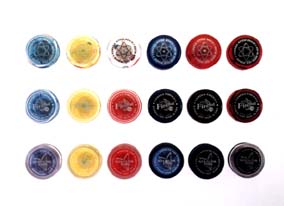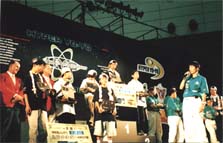WHAT'S COOL IN JAPAN January-March 1998 |
|
Hyper Yo-Yos
|
 Yo-yos are making a big comeback among school kids in Japan, thanks to new flashy models that make it easier to do tricks. Unlike the old types, the souped-up versions can automatically generate momentum so they keep spinning longer, allowing even novices to do fairly hard tricks.
Yo-yos are making a big comeback among school kids in Japan, thanks to new flashy models that make it easier to do tricks. Unlike the old types, the souped-up versions can automatically generate momentum so they keep spinning longer, allowing even novices to do fairly hard tricks.
The new toys are being sold as Hyper Yo-Yos in Japan. They're actually made in America and first came to Japan when tourists brought them back from Hawaii and other places as souvenirs. The toy maker Bandai, which also makes the Tamagotchi virtual pet, realized they could go over really big in Japan and began importing them from a number of American companies. The toy maker's hunch was right: Since it put the Hyper Yo-Yos on the Japanese market in April 1997, it's sold about 7 million units in a little less than a year. The new yo-yos do a lot more than just go up and down. Among the more common tricks are "loop the loop," in which you swing the yo-yo in front of you and instead of catching it, you swing it out for another loop; "rock the baby," where a "sleeping" (spinning at the end of the string) yo-yo is swung back and forth inside a triangle shaped by holding the string using both hands; and "walk the dog," in which you roll a sleeping yo-yo along the ground. Some of the harder tricks include the "pinwheel," where you pinch the string about 20 centimeters (8 inches) from the yo-yo and swing it around; and the "double loop," in which you do "loop the loop" with both hands. Japanese kids tend to have a hectic schedule, not just with school but also with after-school juku(cram school) and lessons of various kinds. But kids like Hyper Yo-Yos so much that they still manage to practice their tricks during the few minutes they have between classes and engagements. The tricks are classified into different levels depending on difficultly, so a lot of yo-yo fans greet each other by asking "What level are you at?" The Hyper Yo-Yos go for between 680 yen and 5,000 yen (around 5 dollars to 40 dollars) and come in all kinds of colors, shapes, and materials. Many of them are specialized to make advanced tricks easier. |
 Bandai holds a national yo-yo contest once a year to choose the Japanese yo-yo champion. It also divides tricks into 30 levels, with 10 levels each being grouped into beginner, intermediate, and advanced ranks. It also sponsors qualification trials at hundreds of department and toy stores around the country to certify what level each player is at. Each time you reach a new level, you get a stamp on a card. A full card qualifies you for a prize and means you're ready to move on to the next rank.
Bandai holds a national yo-yo contest once a year to choose the Japanese yo-yo champion. It also divides tricks into 30 levels, with 10 levels each being grouped into beginner, intermediate, and advanced ranks. It also sponsors qualification trials at hundreds of department and toy stores around the country to certify what level each player is at. Each time you reach a new level, you get a stamp on a card. A full card qualifies you for a prize and means you're ready to move on to the next rank.
Bandai also holds a lot of events on Yo-Yo Day on April 4. The reason this date was chosen is because "four" in Japanese is pronounced yon; the fourth day of the fourth month can be thought of as yon-yon, which sounds a bit like yo-yo.
Photo: (Top) The yo-yos come in all sorts of colors and designs; (above) yo-yo champs receive their awards at an April 4 tornament. (©BANDAI 1998·YOMEGA·THP) |
 |